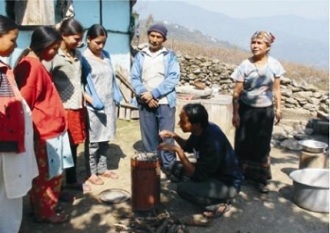BMC Public Health 2011, 11:498
Indoor solid fuel use and tuberculosis in China: a matched case-control study
Full-text: http://www.biomedcentral.com/1471-2458/11/498/abstract
Xiaohong Kan , Chen-Yuan Chiang , Donald A Enarson , Wenhua Chen , Jianan Yang and Genwang Chen
Background – China ranks second among the 22 high burden countries for tuberculosis. A modeling exercise showed that reduction of indoor air pollution could help advance tuberculosis control in China. However, the association between indoor air pollution and tuberculosis is not yet well established. A case control study was conducted in Anhui, China to investigate whether use of solid fuel is associated with tuberculosis.
Methods – Cases were new sputum smear positive tuberculosis patients. Two controls were selected from the neighborhood of each case matched by age and sex using a pre-determined procedure. A questionnaire containing demographic information, smoking habits and use of solid fuel for cooking or heating was used for interview. Solid fuel (coal and biomass) included coal/lignite, charcoal, wood, straw/shrubs/grass, animal dung, and agricultural crop residue. A household that used solid fuel either for cooking and (/or) heating was classified as exposure to combustion of solid fuel (indoor air pollution). Odds ratios and their corresponding 95% confidence limits for categorical variables were determined by Mantel-Haenszel estimate and multivariate conditional logistic regression.
Results – There were 202 new smear positive tuberculosis cases and 404 neighborhood controls enrolled in this study. The proportion of participants who used solid fuels for cooking was high (73.8% among cases and 72.5% among controls). The majority reported using a griddle stove (85.2% among cases and 86.7% among controls), had smoke removed by a hood or chimney (92.0% among cases and 92.8% among controls), and cooked in a separate room (24.8% among cases and 28.0% among controls) or a separate building (67.8% among cases and 67.6% among controls). Neither using solid fuel for cooking (odds ratio (OR) 1.08, 95% CI 0.62-1.87) nor using solid fuel for heating (OR 1.04, 95% CI 0.54-2.02) was significantly associated with tuberculosis. Determinants significantly associated with tuberculosis were household tuberculosis contact (adjusted OR, 27.23, 95% CI 8.19-90.58) and ever smoking tobacco (adjusted OR 1.64, 96% CI 1.01-2.66).
Conclusion – In a population where the majority had proper ventilation in cooking places, the association between use of solid fuel for cooking or for heating and tuberculosis was not statistically significant.



